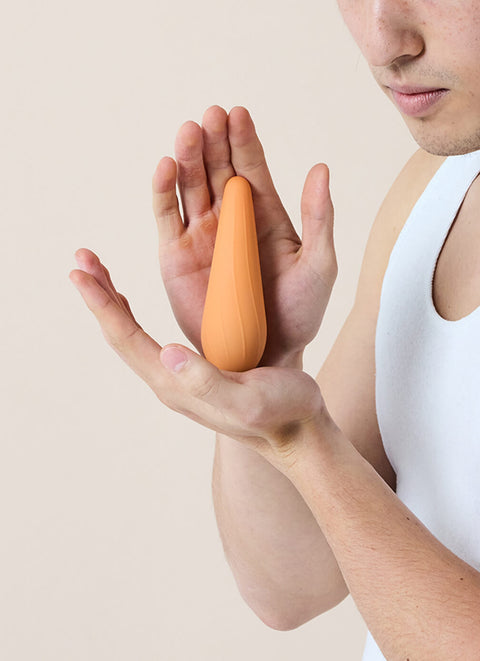Is there such thing as the 'orgasm gap'?
If you’re a woman or someone with a vulva, and you’ve had sex without having an orgasm, you’re not alone. In fact, you’re in pretty good company.
When Cosmopolitan magazine published the results of their Female Orgasm Survey, the results were heard around the world.
Only 57% of women surveyed reported orgasming most or every time they had sex with a partner, while those same women said their partner has an orgasm 95% of the time.
78% of women said they believe their partner cares about whether or not they orgasm, but almost the same amount of women said they’d had a partner climax and then not try to help them finish as well.
67% percent of women had faked an orgasm, and many women responded that they had faked it because they didn’t want to hurt their partner’s feelings by not coming, and they also wanted to get sex over quickly because they knew it wasn’t going to happen.
Basically, Cosmopolitan’s now-famous survey found out that women weren’t having orgasms at the same rate as their partners, and these findings have been echoed by many surveys since.
The Australian Study of Health and Relationships found that only 5.2% of heterosexual men didn’t climax during their last sexual encounter, while almost one in three women—31.1%—didn’t climax during theirs.
A study on sex in Queensland found that 24.3% of women were sometimes unable to come to orgasm, but that problem was only experienced by 4.6% of men.
In the US, the National Survey of Sexual Health and Behaviour discovered that while 85% of men reported that their partner had an orgasm the last time they had sex, only 65% of women reported having an orgasm the last time they had sex.
These differences are big—so big that they’ve been called the ‘orgasm gap’.
Why does the orgasm gap occur?
So why does the orgasm gap occur? Is it as simple as, ‘heterosexual men are bad at sex and women are suffering because of it’? Not quite.
There are a few theories behind the orgasm gap, and we think that all of them may have something to do with it.
Not all of these will be applicable or relevant to every relationship, but we think there are some great takeaways here.
We’re also aware that we’re leaning pretty heavily into some heteronormative, binary assumptions about gender here, but we’ll talk about that more in a few paragraphs.
Women need more than just penetration to climax
The proof is in the proverbial pudding here.
Participants in the original Cosmo survey reported that sometimes they weren’t able to come because they didn’t have any clitoral stimulation from their partner, or it was the wrong kind of clitoral stimulation for them.
They also gave information on how their orgasms do happen: 39% said they came when masturbating, 20% said they came when combining clitoral stimulation with vaginal penetration, and 12% said they came when their partner performed oral on them.
To us, this says that some women (or even most women) need more than penetration alone to make them come, which is something that’s been echoed by sex researchers in recent history.
But that doesn’t necessarily mean that men, by default, have an easier time reaching orgasm than women.
This TED article about the orgasm gap points out that research conducted by the Kinsey Institute found women and men reach orgasm in roughly the same amount of time when masturbating—but if women aren’t reaching orgasm when with a partner, it could mean that some men have a misunderstanding about what their female partners need to orgasm. Which isn’t a surprise, because...
Women’s sexual pleasure is misrepresented in the media and pornography
We rarely see realistic depictions of sex in the media, or in porn. We couldn’t think of a film or television show in which a heterosexual couple is shown having sex, and the man (or the woman) reaches down to stimulate her clitoris.
It does happen in porn, but often after a few seconds of clitoral stimulation the woman orgasms—and that just isn’t how it tends to happen in real life.
Sex therapist Tanya Koens points out that women can need around 45 to 60 minutes to get fully aroused, but on screen are often shown climaxing from penetration after only a minute or two.
Porn in and of itself isn’t problematic, but with more and more of us watching porn, these unrealistic depictions of sex could be giving us the wrong idea of what it really takes to pleasure a partner, or ourselves.
Also adding to this misrepresentation is the fact that...
Even scientists don’t fully understand women’s sexual pleasure or anatomy
There’s a lot of misinformation and mystery about the clitoris and about the way women experience pleasure.
When urologist Helen O’Connell was training to be a surgeon, medical textbooks had less than one paragraph about the clitoris—and this wasn’t one hundred years ago, this was thirty years ago.
If even medical professionals have such a limited understanding of the one organ in the body designed to give pleasure, how is the average person supposed to get a thorough education in what their body can do?
Many of us have learnt about our bodies through experimentation and peer education, but we shouldn’t have had to.
Sex education should include discussion of the clitoris, not only because it’s relevant to sexual pleasure but because it can help us in a medical context discussing pain, changes to our body, or fertility.
A 2016 survey showed that 44% of British women surveyed were unable to identify the vagina on a diagram they were shown—to us, that means that there needs to be way more done to educate people on their anatomy.
But there’s one more thing that may be affecting the orgasm gap, and it also reveals a problem with the whole idea of ‘the orgasm gap’.
We still approach sex with a binary view
In writing this article, we were really aware that we were centering on the experiences of cisgender, heterosexual women who had sex with cisgender, heterosexual men.
There have been a few studies done on couples in same-gender relationships (one found that gay and bisexual men were the second- and third-most likely to orgasm during sex, followed by lesbian and bisexual women, and finally heterosexual women) but there’s very little information available about the experiences of trans and non-binary people.
This is indicative of a wider problem within science: both gender and sex are still seen as existing in a binary.
“Men’s orgasms tend to be innate, instinctive and relatively unmediated,” writes Professor Annamarie Jagose.
“While women’s are acquired with difficulty, [are] unpredictable and the effect of a complex balance of biological, psychological, environmental and social components.”
This view of orgasm, that men have it easy and women have it tough, doesn’t do anyone any favours.
Not men, who are assumed to come easily and might think there’s a problem if they don’t, and not women, who may meet partners who assume their orgasms are so complex and rare that they’re just not worth trying for.
While the concept of the orgasm gap does raise rightful concerns with the pleasure discrepancy between some men and women, Annamarie makes the point that maybe we need to reframe our thinking about the orgasm altogether.
“The radical non-synchronicity of women’s and men’s sexual responses makes heterosexual sex problematic and, whether erotically heroic or incompetent, men are the most significant social actors in securing female orgasms,” she writes.
The orgasm gap, much like the orgasm itself, doesn’t look the same for everyone.
Some people may find themselves among the women who have trouble orgasming with a partner, and some may not—others may not see themselves represented in the discussion around the orgasm gap at all.
We’re for any discussion that brings sex education and sexual pleasure to people’s attention, but we are still hopeful that the orgasm gap can be seen as a starting point to promote more education and research into pleasure as much as it is a problem to be solved.
To learn more about the foundations of great sex with acclaimed sex coach Georgia Grace, check out NORMAL's video masterclass, The Modern Guide To Sex.



































